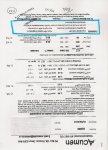@Kimsie,
I have put in attachment one page of results from Acumen Labs about ATP study (ordered by Dr Myhill).
Along with comments from Dr Myhill : (tried to keep short)
1. levels of ATP :
With excess Mg added :1.49 (range : 16-2.9) ==> very low, Dr Myhill recommended D-ribose
With endogenous Mg : 0.77 (range 0.9-2.7) ==>very low ATP-related magnesium status. Magnesium injections recommended
2. oxydative phosphorylation :
- ADP to ATP conversion efficiency : 50.7%.
Dr Myhill's comment that it is running slow (normal range >60%). But the rate of 8.7% signifies that there is no significant blockage of the active sites (up to 14% = normal).
- vitamin B3 (red cell NAD) : 10.6 (range 14.0-30.0) fairly marked deficiency
comments : reflects function of Krebs citric acid cycle. therefore to see normal levels of NAD needs not only an adequate supply of B3 but also a functionning Kreb's citric acid cycle. So a low NAD (amongst other things) also imply a poor acetyl L carnitine level. ==> supplementation
-serum L carnitine : 30.5 umol(34-48) poor result.==> suplementation
- co-enzymeQ10 (sample haemolized)
{...}
This result simply shows how well oxidative phosphorylation is working at the time the test was taken. Does not predict what will happen if the patient increases exercice levels. So it is important to continue pacing carefully.
3. Movement of ATP and AFP accross mitochondrial membranes :
This is dependant on translocator proteines (TR).
- TR 'out' is poor 22.8% (normal range >35%).
TR can be blocked in many different ways -the commonest toxic stress.==> detox (FIR sauna etc)
- TR 'in' slightly abnormal result 80.5% (normal range 55-75%). This indicates rapid depletion of mitochondrial ATP on energy demand, which is again probably due to substrate deficiency.
ATP to start off with is rather low (302). ie there is not much reserve there when energy demands are made on the cell.
However when the energy demands is made, ATP is rapidly used-up and whisked back into the mitochondria in order to be regenerated.
==> D-ribose should be helpful.
Another possible reason for TL protein blockage is intracellular acidosis.
-cell-free DNA : 16.2 ug/l (normal range up to 9.5). good measure of cellular damage.
(poor antioxidant status, toxic strss, immune activation,poor mito function, patient not pacing well).
- Superoxide Dismutase :
- SODase result is poor 39% (normal >40%, but very narrow range. small deviation significant clinically)
-Enzyme Zn/Cu form is 221 (240-410 norme), Mn form 148 (125-208) and extra cellular Zn/Cu 43 (28-70).
This shows a deficiency in Zinc and copper.
Super oxide dismutase is the most important super oxide scavenger in muscles.
- gene study normal (for Zn/Cu SODase) with low enzyme activity.
both genes for Mn-SODase and EC-SODase are normal.
==> doubltly important to tackle antioxidant status.
-Red cell glutathione peroxidase (GSH-PX) : 53U/gHb (67-90) very poor result.
red cell glutathione (GSH) : 1.83 mmol/l (1.7-2.6) - low normal result.
==>glut supplement recommended + high protein diet (amino acids for endogenous synthesis of glut.) + supplementation in Selenium.

